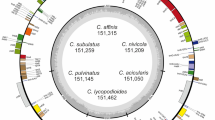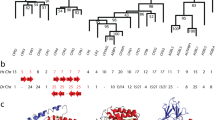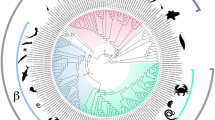Abstract
TWO isoenzymes of aspartate aminotransf erase (AAT) occur in animal and possibly in all eukaryotic cells, one in the cytosol (cAAT) and the other in the mitochondria (mAAT)1. Both isoenzymes are composed of two identical polypeptide chains of about 400 amino acid residues and their reaction mechanisms and kinetic features are essentially the same1,2. They are homologous proteins, as evidenced by 48% sequence identity of the two isoenzymes from pig3,4, and are both coded for by nuclear DNA and synthesised by cytosolic ribosomes5–7. Comparison of the isoenzymes from pig with those from chicken by quantitative microcomplement fixation has shown that the interspecies similarity of the mitochondrial isoenzymes markedly exceeds that of the cytosolic isoenzymes8. The same conclusion has been reached by comparison of the known amino acid sequences of the pig isoenzymes3,4 with the chicken isoenzymes, for which more than half of their sequences have already been determined. The sequence identity of the two cytosolic isoenzymes seems to be approximately 50% (Y. M. Torchinsky, personal communication), whereas that of the two mitochondrial isoenzymes is about 85% (ref. 9 and U. Hausner, P. C., K. J. Wilson, unpublished). In the present study, the immunological interspecies comparison of the two isoenzymes was extended to species of all vertebrate classes. The evolution of the two compartmented isoenzymes was found to have proceeded at identical and constant rates throughout the development of the nonmammalian vertebrates. After the emergence of mammals, however, the rate of evolution of the cytosolic isoenzyme more than doubled while its mitochondrial counterpart retained the slower rate of the nonmammalian vertebrates.
This is a preview of subscription content, access via your institution
Access options
Subscribe to this journal
Receive 51 print issues and online access
$199.00 per year
only $3.90 per issue
Buy this article
- Purchase on Springer Link
- Instant access to full article PDF
Prices may be subject to local taxes which are calculated during checkout
Similar content being viewed by others
References
Braunstein, A. E. in The Enzymes, Vol. 9, 3rd edn (ed. Boyer, P. D.) 379–481 (Academic, New York, 1973).
Gehring, H., Rando, R. R. & Christen, P. Biochemistry 16, 4832–4836 (1977).
Ovchinnikow, Yu.A. et al. FEBS Lett. 29, 31–34 (1973).
Kagamiyama, H., Sakakibara, R., Wada, H., Tanase, S. & Morino, Y. J. Biochem. 82, 291–294 (1977).
van Heyningen, V., Craig, I. W. & Bodmer, W. F. in The Biogenesis of Mitochondria (eds Kroon, A. M. & Saccone, C.) 231–244 (Academic, New York, 1974).
Davidson, R. G., Cortner, J. A., Rattazzi, M. C., Ruddle, F. H. & Lubs, H. A. Science 169, 391–392 (1970).
Schatz, G. & Mason, T. L. A. Rev. Biochem. 43, 51–87 (1974).
Sonderegger, P., Gehring, H. & Christen, P. J. biol. Chem. 252, 609–612 (1977).
Gehring, H., Wilson, K. J. & Christen, P. Biochem. biophys. Res. Commun. 67, 73–78 (1975).
Champion, A. B., Prager, E. M., Wachter, D. & Wilson, A. C. in Biochemical and Immunological Taxonomy of Animals (ed. Wright, C. A.) 397–416 (Academic, New York, 1974).
Ruoslahti, E. & Wigzell, H. Nature 255, 716–717 (1975).
Reichlin, M. & Noble, R. W. in Immunochemistry of Proteins, Vol. 2 (ed. Atassi, M. Z.) 311–351 (Plenum, New York, 1977).
Ziswiler, V. Wirbeltiere, Vols 1, 2 (Georg Thieme, Stuttgart, 1976).
Prager, E. M. & Wilson, A. C. J. biol. Chem. 246, 5978–5989 (1971).
Champion, A. B., Soderberg, K. L., Wilson, A. C. & Ambler, R. P. J. molec. Evol. 5, 291–305 (1975).
Wilson, A. C., Carlson, S. S. & White, T. H. A. Rev. Biochem. 46, 573–639 (1977).
Kitto, G. B., Kottke, M. E., Bertland, L. H., Murphey, W. H. & Kaplan, N. O. Archs Biochem. Biophys. 121, 224–232 (1967).
Reed, R. E. & Hess, J. L. J. biol. Chem. 250, 4456–4461 (1975).
Goodman, M., Moore, G. W. & Matsuda, G. Nature 253, 603–608 (1975).
Dickerson, R. E. J. molec. Evol. 1, 26–45 (1971).
Gehring, H. et al. J. molec. Biol. 115, 97–101 (1977).
Arnone, A. et al. J. molec. Biol. 112, 509–513 (1977).
Borisov, V. V. et al. Dokl. Akad. Nauk SSSR 235, 212–215 (1977).
Author information
Authors and Affiliations
Rights and permissions
About this article
Cite this article
SONDEREGGER, P., CHRISTEN, P. Comparison of the evolution rates of cytosolic and mitochondrial aspartate aminotransferase. Nature 275, 157–159 (1978). https://doi.org/10.1038/275157a0
Received:
Accepted:
Published:
Issue Date:
DOI: https://doi.org/10.1038/275157a0
This article is cited by
-
The complete amino acid sequences of cytosolic and mitochondrial aspartate aminotransferases from horse heart, and inferences on evolution of the isoenzymes
Journal of Molecular Evolution (1986)
-
Evolutionary implications of error amplification in the self-replicating and protein-synthesizing machinery
Journal of Molecular Evolution (1984)
-
Correlations between heterozygosity and evolutionary rate of proteins
Nature (1982)
-
Biochemical and genetic consequences of gene transfer from endosymbiont to host genome
Journal of Molecular Evolution (1982)
-
Reactivity of sulphydryl groups of cytosolic and mitochondrial bovine aspartate aminotransferases
Molecular and Cellular Biochemistry (1981)
Comments
By submitting a comment you agree to abide by our Terms and Community Guidelines. If you find something abusive or that does not comply with our terms or guidelines please flag it as inappropriate.



